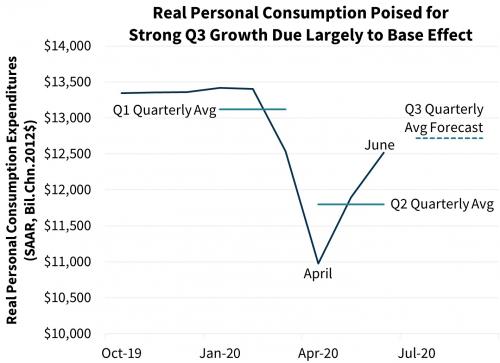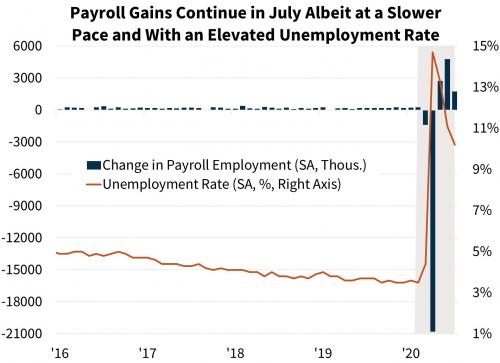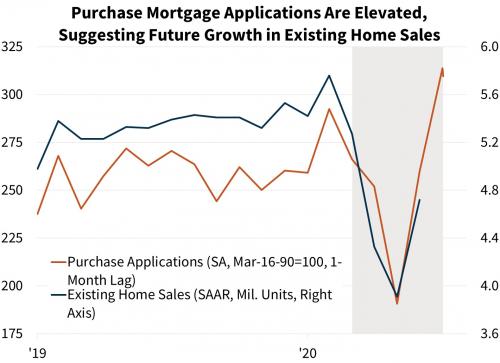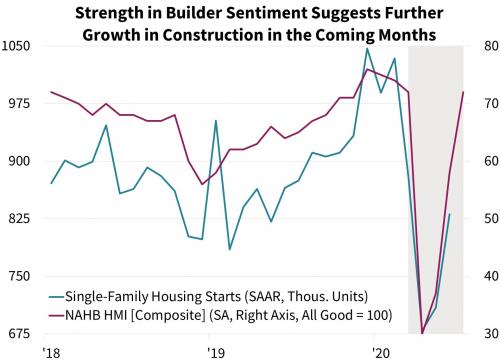Historic Decline in Q2 GDP but Q3 Rebound Is Likely Ahead
As of the time of this writing, new COVID-19 (coronavirus) cases are declining within the United States. Combining the elevated savings rate of 19 percent in June and extremely accommodative fiscal and monetary policy to date, we expect growth to accelerate toward year-end. Recent high frequency data on mobility and credit card expenditures suggest that activity may have accelerated modestly in late July. We now expect Q3 gross domestic product (GDP) to grow at an annualized pace of 27.2 percent and have upgraded our full-year 2020 forecast to a 3.1 percent decline, up from our prior forecast of a 4.2 percent contraction.
Second quarter real GDP declined 32.9 percent on an annualized basis as the economy felt the brunt of coronavirus-related shutdowns. The decline was slightly less than our previous forecast of a 34.8 percent contraction due in part to reimbursed origination fees related to Paycheck Protection Program (PPP) loans unexpectedly boosting federal government expenditures. Still, the quarterly decline was the deepest since at least 1947, the start of the quarterly GDP data series.
The contraction would have been even greater if not for a partial recovery beginning in the second half of the quarter. Real personal consumption expenditures (PCE) rose 5.2 percent in June, following an 8.3 percent rebound in May. More recently, early indicators suggest that the pace of growth slowed in July, corresponding with the spike in coronavirus cases over the same time period. However, the earlier improvement means that economic activity began the third quarter at a pace much higher than the second quarter average. We expect this will translate into a historically strong Q3 growth rate, even if growth on a monthly basis through the remainder of the summer is comparatively minimal.
Residential fixed investment declined at a 38.7 percent annualized rate in the second quarter, but since its trough in April, housing activity has continued to show remarkable strength. Monthly housing data for June came in near our expectations, but more recent mortgage applications data and other high-frequency indicators showed greater strength than we had previously expected. Consistent with expected stronger economic growth, we revised upward our forecast for home sales for the remainder of the year. We now project full-year existing sales to fall 4.5 percent (compared to our prior forecast of a 7.5 decline) and new home sales to rise 0.9 percent (compared to our prior expectation of a 2.4 percent decline). The stronger outlook for sales along with upward revisions of historical data based on the CFPB’s release of Home Mortgage Disclosure Act (HMDA) data for 2019 led us to upgrade our forecast for 2020 mortgage originations to $3.4 trillion, from the $3.1 trillion in our July forecast.
Coronavirus and Uncertain Fiscal Policy Remain Heightened Risks
Risks to the forecast related to the coronavirus and fiscal policy remain elevated. The early third quarter flare-up in coronavirus cases in the Sun Belt was the largest increase since the initial outbreak, yet economic growth appears to have, at most, paused, compared to turning negative as it did during the second quarter. We interpret this as an indication that any future waves of coronavirus cases of a similar magnitude are likely to slow economic growth rather than cause a contraction. Still, the potential for more aggressive shutdowns and social distancing measures remains a downside risk.
We assume that behavioral changes due to the coronavirus will still be a factor in 2021 and expect a substantial segment of economic activity to recover slowly. For instance, hospitality and travel activities will likely not return to normal for a number of years. We therefore expect the pace of growth to decelerate meaningfully in 2021 as sectors less harmed by social distancing measures near full recovery. If a vaccine or other treatment proves effective and is widely adopted, then in the near term this would likely allow some sectors of the economy to recover more quickly. We expect the household savings rate to remain high, even in the absence of additional government transfer payments, so if consumers are able and willing, they should have the ability to drive further consumption growth.
We assume that, in addition to the recently announced executive orders, a stimulus bill will be enacted during the next few weeks in the range of $1.0 to $1.5 trillion that includes some level of elevated unemployment benefits and an additional round of checks to households. Given the elevated unemployment rate, if this fails to materialize, short-term growth in Q4 and early 2021 would likely be somewhat lower than currently forecast (however greater room for growth in later 2021 may remain). More broadly, a wide range of policy outcomes is possible following the November election, leading to increased future uncertainty around the forecast.
Unemployment Remains Elevated, but Labor Market Improves as Consumers Maintain Spending Power
Nonfarm payroll employment rose by 1.8 million in July, following a 4.8 million jump in June. While the July gain represented a large deceleration and the unemployment rate remained high at 10.2 percent, the continued pace of job recovery was strong considering it occurred during a period of growing coronavirus cases. This suggests that the labor market will likely continue to improve, even if at a somewhat slower pace. We forecast the unemployment rate will remain elevated through the end of the year but will fall below 9.0 percent by December.
High-frequency credit card data suggest that consumer spending leveled off in July, consistent with the pullback in consumer confidence surveys. Auto sales, however, continued to recover over the month, jumping 10.2 percent, and there was likely an additional increase in healthcare spending due to delayed non-essential procedures from earlier in the spring. On net, we expect personal consumption to rise in July but at a much slower pace than in June, before leveling off or even declining slightly in August.
We now forecast modest growth of 1.6 percent annualized in business fixed investment in the third quarter. The ISM survey measuring manufacturing activity rose 1.6 points in July to 54.2, the second consecutive month above the expansionary threshold of 50. Core capital goods orders, a forward-looking indicator, rose 3.4 percent in June, suggesting modest improvement in equipment expenditures early in the third quarter. The production side of the economy lagged the rebound in consumption in May and June, as firms drew down inventories to meet demand. While additional destocking is likely in the near term, much of that rebalancing process has probably passed, and eventually manufacturing will have to accelerate.
The July meeting of the Federal Reserve offered no real surprises. The Fed voted to keep the federal funds rate at the zero lower bound and continued to express worry over the coronavirus’ impact on the economy. With interest rates as low as the Fed is likely willing to go, asset purchases remain its primary tool of support. Purchases of Treasury securities and mortgage-backed securities continued steadily, but the Fed, which made its first foray into buying corporate debt this year, tapered down these purchases substantially over July. Ratcheting down corporate debt purchases from around $180 million a day in May to about $20 million a day in July is likely a sign that markets are functioning more efficiently and that credit is more readily available.
Housing Shows Remarkable Strength, but Softening Sales Expected
Roughly in line with expectations, June existing home sales rebounded strongly, rising 20.7 percent to 4.72 million annualized units. June pending sales, which lead closings by 30 to 45 days on average, rose 16.6 percent to a level eclipsing February’s prior peak. This suggests July existing sales could approach a level not seen since 2006. The fast pace of sales is thought to be largely due to pent-up demand as buyers who delayed home purchases earlier in the spring are now pursuing the opportunity. In addition, some would-be buyers may be accelerating home purchase plans to take advantage of low mortgage rates or because they are reassessing their housing preferences in light of lockdowns and social distancing.
Regardless of the motivation, the elevated pace of sales is not sustainable given the continued tight levels of inventory. Months’ of supply of existing homes for sale will likely approach or even fall below record lows in the upcoming July reading. The pace of new listings has grown much more slowly than recent purchase demand. In July, new single-family for-sale listings trended largely sideways and remained below year-ago levels. The Fannie Mae Home Purchase Sentiment Index® (HPSI) in July continued to show that a smaller net share of respondents say it is a good time to sell compared to the sentiment around homebuying. Thus, we continue to expect a pullback in sales in coming months. On the other hand, recent mortgage application data from the Mortgage Bankers Association suggests that while sales are slowing somewhat, the pace has held up considerably better than we previously anticipated. As a result, we upgraded our forecast for Q3 and Q4 existing sales.
New home sales jumped 13.8 percent in June to the highest level since 2007. Single-family housing starts also rose, increasing 17.2 percent, but to a level significantly below pre-pandemic levels. The comparatively weaker pace of starts in recent months relative to sales reflects homebuilders depleting inventories of homes already started. Builders offered heavy discounting to move product at the height of the shutdowns. On many publicly traded homebuilders’ second quarter earnings calls a common theme was that “spec inventory” has diminished and that building programs needed to be accelerated. This is consistent with the National Association of Home Builders’ Housing Market Index, which jumped 14 points in July, climbing back to pre-pandemic levels. The lack of existing homes for sale appears to be bolstering demand for new construction.
We also believe there is another dynamic in play with new construction. Internal data here at Fannie Mae show that across most major metro areas there has been a substantial increase in purchase mortgage applications for homes in lower density areas by those currently living in urban cores. Zip code-level house price measures from Zillow also show that in many metro areas changes in price appreciation have been comparatively weak in urban areas relative to the outer suburbs. It is too soon to tell whether this represents a permanent shift to the suburbs as remote working becomes more prominent and concern over social unrest impacts preference, or if this is a temporary phenomenon, representing a portion of urban dwellers accelerating their plans to move due to social distancing and low interest rates. Regardless, for the time being, this dynamic appears to be more than anecdotal. This should help to support new single-family home construction and sales in coming months as demand appears to be shifting on the margins to locations where available land makes new single-family construction more feasible.
In the current quarter, we increased our forecast for new single-family starts and sales considerably, though still we expect starts will need to play catch-up to sales. We now project single-family starts to increase to a pace of 904,000 annualized units in Q3 compared to our prior forecast of 815,000. For 2020, we now forecast a decline of only 0.7 percent compared to our prior forecast of a 6.1 percent decline. We expect new home sales will increase to around 685,000 annualized units in Q3 and to 689,000 for the year, up from 660,000 and 667,000, respectively.
We believe some of the dynamics that support single-family construction will likely have the opposite effect on multifamily. While the data series tends to be extremely volatile and subject to large revisions, multifamily starts rose 17.5 percent in June. However, given the length of project pipelines, this jump likely reflects ventures already deep into the planning stages. We expect multifamily construction starts to be comparatively weak in coming quarters relative to single-family starts.
For more on multifamily market conditions please see the August 2020 Multifamily Market Commentary.
Mortgage Originations Expected to Be Higher
We updated our historical estimate of 2019 single-family mortgage originations due to our annual benchmarking of the recently released HMDA data. The result was an increase in estimated total origination volumes by 6.8 percent in 2019 to $2.5 trillion, with purchase volumes increasing by 2.7 percent to $1.3 trillion and refinance volumes increasing 12.1 percent to $1.1 trillion.
On the purchase side, in addition to revising upward our estimate of 2019 mortgage originations, the HMDA release implied a higher path for purchase volumes into 2020 and 2021 as well. Combined with upward revisions to our home sales forecast, we now expect purchase volumes to be $1.3 trillion in 2020, about $74 billion higher than last month’s forecast. Purchase volumes are then projected to grow about 1.8 percent in 2021 as the broader economy continues to improve.
The HMDA benchmarking also resulted in an upward revision to our projected 2020 refinance volumes. Given the improved view on the size of the refinance originations market and the continued low mortgage rate environment, we expect refinances in 2020 to reach $2.1 trillion, an upward revision of 10.3 percent relative to last month’s forecast. While we expect refinance volumes to fall to $1.1 trillion next year, historically low mortgage rates should sustain refinance demand for the near future. According to Freddie Mac, the 30-year fixed mortgage rate fell to 2.88 percent in the first week of August, a new all-time low. At the current mortgage rate, we estimate that 65 percent of all outstanding loan balances have at least a half-percentage point incentive to refinance.
Despite reaching an all-time low this month, the 30-year fixed mortgage rate decline to date has been considerably slower than the fall in the 10-year Treasury yield. The primary mortgage spread (30-year mortgage rate minus the 10-year Treasury yield) has remained elevated compared to historical norms, likely due to continued lender volume constraints, though these appear to be diminishing. As of this writing, the primary spread sat around 225 basis points, down from April’s peak of 272 basis points, but well above 2019’s average of 180 basis points. We expect the compression of this spread to continue in the short run, bringing mortgage rates down closer to 2.7 percent by early 2021, providing support for home purchase and refinance activity.
Economic & Strategic Research (ESR) Group
August 11, 2020
For a snapshot of macroeconomic and housing data between the monthly forecasts, please read ESR’s Economic and Housing Weekly Notes.
Bureau of Economic Analysis, Fannie Mae ESR Group, Bureau of Labor Statistics, Mortgage Bankers Association, National Association of REALTORS®, Census Bureau, National Association of Home Builders.
Opinions, analyses, estimates, forecasts and other views of Fannie Mae's Economic & Strategic Research (ESR) Group included in these materials should not be construed as indicating Fannie Mae's business prospects or expected results, are based on a number of assumptions, and are subject to change without notice. How this information affects Fannie Mae will depend on many factors. Although the ESR group bases its opinions, analyses, estimates, forecasts and other views on information it considers reliable, it does not guarantee that the information provided in these materials is accurate, current or suitable for any particular purpose. Changes in the assumptions or the information underlying these views could produce materially different results. The analyses, opinions, estimates, forecasts and other views published by the ESR group represent the views of that group as of the date indicated and do not necessarily represent the views of Fannie Mae or its management.
ESR Team
ESR Macroeconomic Forecast Team
- Doug Duncan, SVP and Chief Economist
- Eric Brescia, Economist
- Rebecca Meeker, Financial Economist
- Mark Palim, VP and Deputy Chief Economist
- Nick Embrey, Economist
- Richard Goyette, Business Analyst




